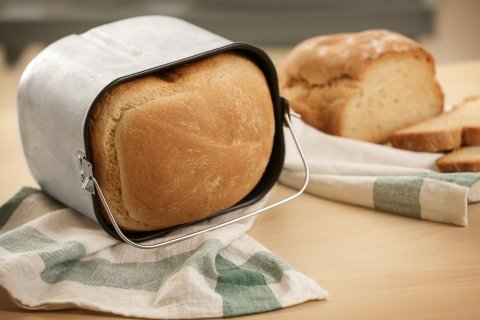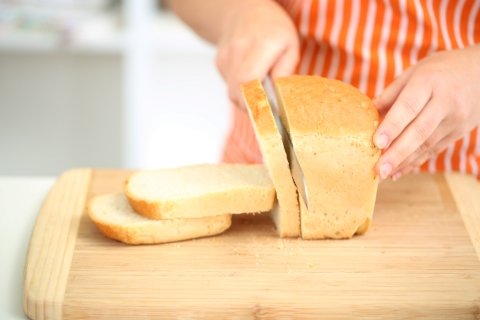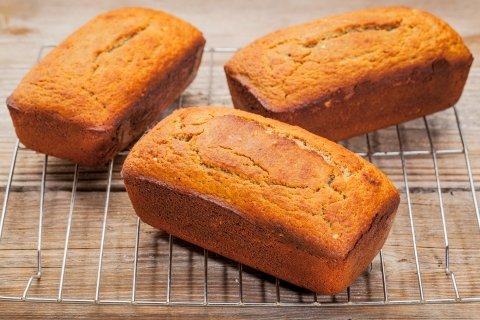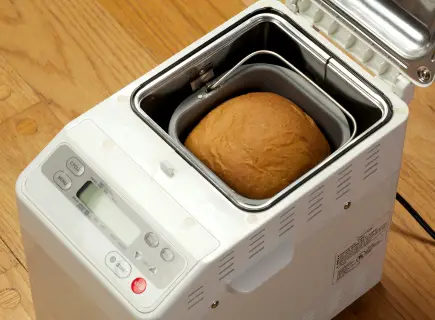Whether you’ve bought a new bread maker or are still experimenting with the one you bought a while ago, learning your way around a bread-making machine can be challenging. “Can you leave bread in a bread machine overnight?” is one of the most frequently asked questions we get about bread machines. And if you’re one of those people looking for answers to this question, we’re here to help.
Simply put, leaving your bread in a bread machine overnight is only recommended if your machine has a delayed cycle. In most cases, however, fully baked bread left in a bread maker will become soggier and softer than it should be. Keep reading to learn more nitty-gritty details.
Table of Contents
- 1 Can you Leave Bread in Bread Machine Overnight?
- 2 When to Remove Bread From Bread Machine
- 3 How Long to Let Bread Cool Before Removing From Pan?
- 4 How Long to Let Bread Cool Before Slicing?
- 5 How to Keep Bread Warm Without Getting Soggy
- 6 How to Keep Bread Machine Bread Soft After Baking
- 7 How to Store Bread From Bread Machine
- 8 How to Soften Bread That Has Hardened
Can you Leave Bread in Bread Machine Overnight?
Bread makers have found their way into many households and even a few restaurants due to their ease of use and efficiency. With the massive increase in demand for this machine, manufacturers are modernizing bread makers to make them more user-friendly and provide better results.
Many newer models and brands on the market include a pre-programmed delayed cycle setting. These machines allow cooks to delay the process and force the machine to start at a time that is more convenient for them. For example, a model can provide 13 hours of delayed time, which means you can set the bread maker ahead of time and it will begin the mixing and kneading cycle 13 hours later.
Despite the fact that the delayed cycle option has become a popular feature, not all brands and models include it, limiting its use and requiring cooks to keep a close eye on their loaves of bread while they’re in the machine. Of course, there’s the beeping that indicates when the bread is ready to be removed. However, if you’re as forgetful as we are and forget to remove your bread from the bread maker, leaving it in the machine overnight, you’ll end up with soft and soggy bread that won’t make a tasty breakfast treat.
Unless you have a Zojirushi Virtuoso Bread Maker with a top heating option, the sogginess and softness will begin at the top, which is the softest part of machine-baked bread. The longer you leave it there, the worse it will get with each minute of condensation.
Furthermore, some bread machines have a “keep warm” or “heating” mode that keeps fully baked loaves of bread warm for up to 60 minutes after the baking cycle is finished. However, keep in mind that the longer you leave your bread in this mode, the harder and thicker the bottom crust will become.
Why is the Bottom of my Bread Wet?
If the bottom of your bread is still moist after baking, it indicates that it is undercooked and has not gotten enough heat at the bottom. You may continue making a soggy bread in your bread machine or transfer it to a baking oven and bake it for 10 to 20 minutes at 350 F. The extra time will be determined by the amount of sogginess or softness you observe.
While baking bread for the first time, always check the temperature or use a long needle/toothpick to examine the consistency of the baked bread. You may also tap the bread to see whether it creates a hollow sound, which indicates that it is thoroughly cooked.
When to Remove Bread From Bread Machine

As previously stated, some bread machines have a warm cycle that lasts around an hour to prevent a completely cooked loaf from becoming mushy or soggy if left in the machine after baking is done. But, leaving it in the machine for more than an hour may cause it to become overly hard and brown. Some cooks prefer a loaf that is tougher and more browned.
If you don’t like such loaves, remove them from the bread machine as soon as the baking cycle is over or, at most, after the warm cycle is finished.
Should you Remove Bread from Bread Machine Immediately?
While it is important to remove the bread from the machine after the baking cycle is over to minimize condensation, which leads to soft and mushy outcomes, some home chefs make the error of removing their loaves of bread as soon as the cycle is finished. This exposes your bread to comparatively cooler air than itself, which might induce condensation and make the crust on the top wrinkled.

There is a simple technique to ensure that your bread does not wrinkle when removed from the machine or turn mushy if left in the machine. Once the baking cycle is over and your bread is thoroughly cooked, proceed with the next steps:
● Remove the bucket from the machine.
● Take your bread out of the bucket.
● Place the bread into the machine without the bucket.
● Leave the lid cracked at about 1 inch.
● Allow the bread to cool in the warm machine at a steady pace.
How Long to Let Bread Cool Before Removing From Pan?
In addition to putting it in the bread machine for too long, keeping your loaf of bread in the pan for too long might have a negative influence on the final product. The bread pan will start to sweat, causing the bread to become soggy and softer than desired.
You can take your bread out from the pan as soon as the baking cycle is through, but use oven gloves to avoid getting burned. To remove your loaf from the bread pan, do the following:
● Open the bread machine’s latch and pull the bread pan out using its handles.
● Turn the bread pan upside down.
● Shake the bread pan [aggressively] over the countertop.
● Place the bread on a cooling rack without the pan.
● Let it cool for at least 10 to 15 minutes.
How Long to Let Bread Cool Before Slicing?

The amount of time it takes for your bread to cool depends on the size of the loaf, the ingredients used, and the style of bread. Sourdough and bigger loaves, for example, can take up to 2 hours to cool down, but smaller loaves, baguettes, and rolls require approximately an hour or 30 minutes to settle.
While waiting at least 10 to 15 minutes is recommended, make sure the inside has set and the bread is at body temperature.
How to Keep Bread Warm Without Getting Soggy
We’ve previously established that the “warm mode” on your bread maker isn’t a viable option if you want to keep your bread warm for more than an hour. So, how can you keep it warm? The following home remedy will assist you in keeping your baked bread warm for a longer amount of time after the baking and warming cycle:
● Grab enough dried beans that could fit the bottom of your breadbasket.
● Wrap the dried beans in a tea towel and heat them in a microwave.
● Lay the bundled beans at the bottom of your breadbasket and place the bread on top of that.
How to Keep Bread Machine Bread Soft After Baking
There are numerous methods for keeping the bread soft after it has been baked. You may keep it in an airtight container, for example, with any exposed sliced end covered by the sliced off piece of bread. If that piece is already eaten then use cling wrap just to cover the end. The following are some tried-and-true strategies for keeping bread moist after baking:
● If you’ve baked bread made with a Tangzhong starter or a sourdough loaf, you can leave it at room temperature to keep it soft and fluffy.
● You can also wrap the bread in single-day portions to freeze and thaw and reheat per your need.
● Store the large and crusty loaves unwrapped.
● Use foil or plastic wrapping instead of cloth to store your baked bread.
How to Store Bread From Bread Machine

The following methods will ensure that your machine-baked bread stays fresh for a longer period of time without becoming hard or stale:
● Let the bread cool on a cooling rack without its pan.
● Use multiple layers of good quality foil or wrapping plastic to wrap the bread once it’s cool.
● You can store this bread in a dark and cool place in your kitchen for about three days.
● Invest in a well-ventilated ceramic bread box, a bread bin, or a plastic storage container with ventilation holes and store your loaf of bread to increase its lifespan to five days in total—[Ensure it’s out of sunlight at all times].
Here’s a more detailed guide on various options for storing homemade bread.
How to Soften Bread That Has Hardened
If your bread has stiffened, it is possible that it has gone stale. Stale bread, on the other hand, may be used to produce a variety of delectable treats such as bread pudding, croutons, and French toast, as well as bread crumbs for your recipes. If you prefer a simple piece of bread, you may restore partial or complete loaves of bread to their natural crusty and soft state by following these steps:
● Preheat the oven to 300 F.
● Run your loaf of bread under running water for a quick few seconds to wet its exterior. (Ensure that it’s not getting moist from the inside while you’re running it under the water).
● Depending on the amount of moisture and the size of the loaf, you will need to heat it in the oven for approximately 6 to 10 minutes or until the exterior becomes crusty and dry.
● Don’t forget to place the bread on a baking sheet before putting it inside the oven.

